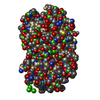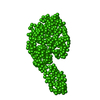+Search query
-Structure paper
| Title | OCP-FRP protein complex topologies suggest a mechanism for controlling high light tolerance in cyanobacteria. |
|---|---|
| Journal, issue, pages | Nat Commun, Vol. 9, Issue 1, Page 3869, Year 2018 |
| Publish date | Sep 24, 2018 |
 Authors Authors | Nikolai N Sluchanko / Yury B Slonimskiy / Evgeny A Shirshin / Marcus Moldenhauer / Thomas Friedrich / Eugene G Maksimov /   |
| PubMed Abstract | In cyanobacteria, high light photoactivates the orange carotenoid protein (OCP) that binds to antennae complexes, dissipating energy and preventing the destruction of the photosynthetic apparatus. At ...In cyanobacteria, high light photoactivates the orange carotenoid protein (OCP) that binds to antennae complexes, dissipating energy and preventing the destruction of the photosynthetic apparatus. At low light, OCP is efficiently deactivated by a poorly understood action of the dimeric fluorescence recovery protein (FRP). Here, we engineer FRP variants with defined oligomeric states and scrutinize their functional interaction with OCP. Complemented by disulfide trapping and chemical crosslinking, structural analysis in solution reveals the topology of metastable complexes of OCP and the FRP scaffold with different stoichiometries. Unable to tightly bind monomeric FRP, photoactivated OCP recruits dimeric FRP, which subsequently monomerizes giving 1:1 complexes. This could be facilitated by a transient OCP-2FRP-OCP complex formed via the two FRP head domains, significantly improving FRP efficiency at elevated OCP levels. By identifying key molecular interfaces, our findings may inspire the design of optically triggered systems transducing light signals into protein-protein interactions. |
 External links External links |  Nat Commun / Nat Commun /  PubMed:30250028 / PubMed:30250028 /  PubMed Central PubMed Central |
| Methods | SAS (X-ray synchrotron) |
| Structure data |  SASDDE9:  SASDDF9:  SASDDG9: |
| Source |
|
 Movie
Movie Controller
Controller Structure viewers
Structure viewers About Yorodumi Papers
About Yorodumi Papers




